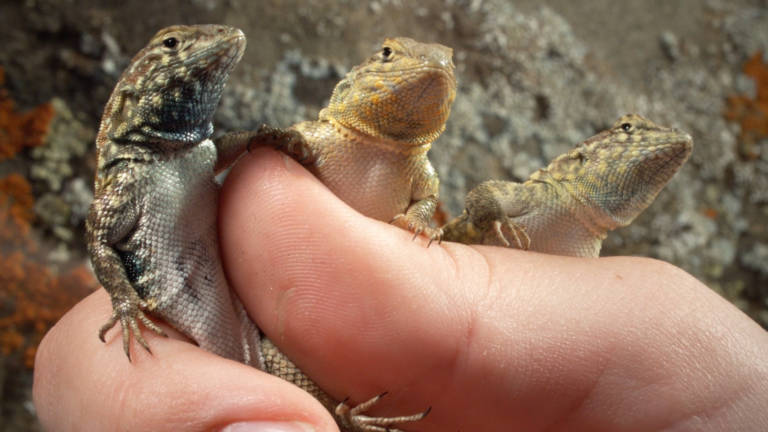The Rock-Paper-Scissors Lizards

Pictured above (via the National Park Service) is a tiny creature known as the common side-blotched lizard. Common in the American southwest, the lizards are small, measuring only a couple of inches at most, and are easily ignored. They get their name from the splotch of pigment just behind their front legs, but that splotch isn’t all that important for, well, any obvious purpose, evolutionarily speaking. But when it comes to evolution, the common side-blotched lizard does something no other species does — it plays an accidental game of Rock-Paper-Scissors.
For those unfamiliar with Rock-Paper-Scissors, it’s a pretty simple game. Two players stand across from each other and, simultaneously (typically after saying “rock paper scissors and shoot!” or “one, two, three, shoot!” in unison) make one of three hand motions. Displaying a closed fist represents a rock. Showing a flat hand represents paper. And if you want to go with scissors, you hold your pointer and middle finger out — you know, like a pair of scissors. The winner is determined via a circular set of rules. If you show rock and your opponent shows scissors, you win, as the rock smashes the scissors. However, if she shows paper, you lose — the piece of paper covers the rock. And if you play paper instead of rock, their scissors will beat you, as scissors are used to cut paper. (Showing the same “object” as your opponent results in a do-over, which isn’t relevant to our lizards.)
But, of course, common side-blotched lizards don’t play Rock-Paper-Scissors, at least not in the traditional sense — they don’t have enough fingers on their front legs and can’t count to three, to begin with. And yet, they come in three different types. Or, at least, the males do. Here’s another picture, below, via PBS affiliate KQED.

Again, all three of those lizards are common side-blotched lizards, and again, all three are male. But they’re very different-looking from one another. The one on the left is considered a blue-throated lizard, the middle one an orange-throated one, and the right one a yellow-throated one. And in this case, their colors matter — a lot. When it comes to mating, each one of them has a different strategy to attract a partner.
As the above-linked National Park Service article explains, “orange-throated males are the largest and produce the most testosterone. This makes them aggressive fighters that bully blue-throated lizards.” In a world with only orange-throated lizards, the blue ones would go extinct — they’d simply be unable to attract a mate and push their genes forward. But then come the yellow-throated males. Typically, the female side-blotched lizards are also yellow-throated and look a lot like the yellow-throated males; per NPS, “yellow-throated male [ . . .] produce little testosterone and are smaller.” The orange-throated lizard, therefore, tend to ignore the yellow one, “allowing them to sneak in and whisk females away from orange males.”
Because the lifespan of the lizards is so short — often, they only live for a year, maybe two — when the orange-throated lizard’s territory expands too far, the yellow ones tend to take over a generation later. And that gives the blue-throated lizard another chance to thrive. Per KQED, “blue males typically hold smaller territories and are more monogamous, each focusing his interest on a single female.” That’s a great way to counter the sneaky habits of their yellow-throated brethren; continues KQED, the orange lizard “aren’t able to guard each individual female against intruding yellow males, [but] the more monogamous blues males are more vigilant and chase sneaky yellow males away.”
The net result is a year-in, year-out, ongoing game of evolutionary Rock-Paper-Scissors. As Smithsonian explains, “orange is most successful when blues are greater in number; yellows are most successful when oranges are greater in number; blues are most successful when yellows are greater in number. The result is a cycle that has persisted for millions of years.” It’s an interesting and unique way for a species to live long and prosper.
Bonus fact: In 2012, a team of Japanese researchers developed a robotic arm that won 100% of Rock-Paper-Scissors matches. (Here’s a video of it in action.) How did they do it? As Engadget reported, “the programmed the robot to recognize its human opponent’s hand shape and counter it within a millisecond.” Or in other words, they cheated.
From the Archives: The Strategy Behind Rock-Paper-Scissors: Maybe it’s not all luck.
